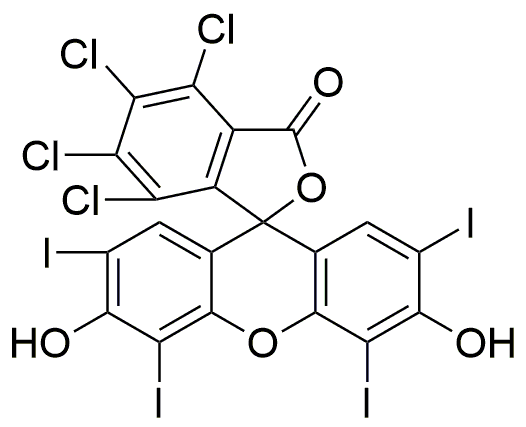Rose Bengal lactone is widely utilized in research focused on:
- Photodynamic Therapy: This compound is used in medical treatments for certain types of cancer. Its ability to generate reactive oxygen species upon light activation makes it effective in targeting and destroying cancer cells while minimizing damage to surrounding healthy tissue.
- Fluorescent Tracers: In biological research, Rose Bengal lactone serves as a fluorescent dye. It is commonly used in microscopy to label cells and tissues, allowing researchers to visualize and track biological processes in real-time.
- Environmental Monitoring: The compound is applied in assessing water quality. It can be used to detect and quantify pollutants, providing valuable data for environmental scientists working to maintain ecosystem health.
- Antimicrobial Applications: Rose Bengal lactone exhibits antimicrobial properties, making it useful in the development of disinfectants and antiseptics. This application is particularly relevant in healthcare settings where infection control is critical.
- Research in Photochemistry: The compound is a valuable tool in photochemical studies, helping scientists explore light-induced chemical reactions. Its unique properties facilitate the understanding of complex photochemical processes.
General Information
Properties
Safety and Regulations
Applications
Rose Bengal lactone is widely utilized in research focused on:
- Photodynamic Therapy: This compound is used in medical treatments for certain types of cancer. Its ability to generate reactive oxygen species upon light activation makes it effective in targeting and destroying cancer cells while minimizing damage to surrounding healthy tissue.
- Fluorescent Tracers: In biological research, Rose Bengal lactone serves as a fluorescent dye. It is commonly used in microscopy to label cells and tissues, allowing researchers to visualize and track biological processes in real-time.
- Environmental Monitoring: The compound is applied in assessing water quality. It can be used to detect and quantify pollutants, providing valuable data for environmental scientists working to maintain ecosystem health.
- Antimicrobial Applications: Rose Bengal lactone exhibits antimicrobial properties, making it useful in the development of disinfectants and antiseptics. This application is particularly relevant in healthcare settings where infection control is critical.
- Research in Photochemistry: The compound is a valuable tool in photochemical studies, helping scientists explore light-induced chemical reactions. Its unique properties facilitate the understanding of complex photochemical processes.
Documents
Safety Data Sheets (SDS)
The SDS provides comprehensive safety information on handling, storage, and disposal of the product.
Product Specification (PS)
The PS provides a comprehensive breakdown of the product’s properties, including chemical composition, physical state, purity, and storage requirements. It also details acceptable quality ranges and the product's intended applications.
Certificates of Analysis (COA)
Search for Certificates of Analysis (COA) by entering the products Lot Number. Lot and Batch Numbers can be found on a product’s label following the words ‘Lot’ or ‘Batch’.
*Catalog Number
*Lot Number
Certificates Of Origin (COO)
This COO confirms the country where the product was manufactured, and also details the materials and components used in it and whether it is derived from natural, synthetic, or other specific sources. This certificate may be required for customs, trade, and regulatory compliance.
*Catalog Number
*Lot Number
Safety Data Sheets (SDS)
The SDS provides comprehensive safety information on handling, storage, and disposal of the product.
DownloadProduct Specification (PS)
The PS provides a comprehensive breakdown of the product’s properties, including chemical composition, physical state, purity, and storage requirements. It also details acceptable quality ranges and the product's intended applications.
DownloadCertificates of Analysis (COA)
Search for Certificates of Analysis (COA) by entering the products Lot Number. Lot and Batch Numbers can be found on a product’s label following the words ‘Lot’ or ‘Batch’.
*Catalog Number
*Lot Number
Certificates Of Origin (COO)
This COO confirms the country where the product was manufactured, and also details the materials and components used in it and whether it is derived from natural, synthetic, or other specific sources. This certificate may be required for customs, trade, and regulatory compliance.


